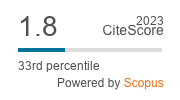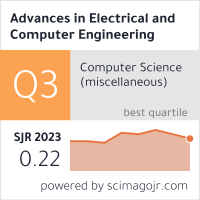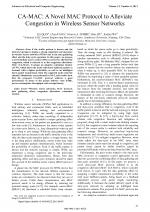| 4/2013 - 7 |
CA-MAC: A Novel MAC Protocol to Alleviate Congestion in Wireless Sensor NetworksQIAN, L. |
| View the paper record and citations in |
| Click to see author's profile in |
| Download PDF |
Author keywords
wireless sensor networks, MAC protocol, data gathering effect, congestion alleviation, contention window
References keywords
sensor(28), networks(22), protocol(8), systems(6), embedded(6), communications(6), networked(5), mobile(5), efficient(5), duty(5)
Blue keywords are present in both the references section and the paper title.
About this article
Date of Publication: 2013-11-30
Volume 13, Issue 4, Year 2013, On page(s): 41 - 46
ISSN: 1582-7445, e-ISSN: 1844-7600
Digital Object Identifier: 10.4316/AECE.2013.04007
Web of Science Accession Number: 000331461300007
SCOPUS ID: 84890239128
Abstract
Even if the traffic pattern is known and the network topology is simple, a strong congestion can take place in wireless sensor networks (WSNs) due to the data gathering effect and the duty-cycle operation. In this paper, we propose a novel medium access control (MAC) protocol to alleviate the congestion, which is referred to as the congestion alleviation-MAC (CA-MAC). It adopts an adaptive contention window (ACW), which allows the nodes with more buffered packets to transmit with a higher probability, as well as an intelligent burst packet transmission when the congested nodes seize the channel. Simulations are performed in NS-2, and results show that the proposed CA-MAC protocol achieves a good performance in terms of the packet delivery ratio (PDR), power consumption, throughput, and average latency. |
| References | | | Cited By «-- Click to see who has cited this paper |
| [1] I. F. Akyildiz, W. Su, Y. Sankarasubramaniam, and E. Cayirci, "Wireless sensor networks: a survey," IEEE Communications Magazine, vol. 40, no. 8, pp. 102 - 114, Mar. 2002. [CrossRef] [Web of Science Times Cited 9472] [SCOPUS Times Cited 13770] [2] I. Demirkol, C. Ersoy and F. Alagz , "Wireless sensor networks: A survey," IEEE Communications Magazine, vol. 44, no. 4, pp.115-121, Apr. 2006. [CrossRef] [Web of Science Times Cited 598] [SCOPUS Times Cited 949] [3] C.-Y. Wan, S. B. Eisenman, A. T. Campbell, and J. Crowcroft, "Overload traffic management for sensor networks," ACM Transactions on Sensor Networks, vol. 3, no. 4, pp. 18-es, Oct. 2007. [CrossRef] [Web of Science Times Cited 27] [SCOPUS Times Cited 53] [4] W. Ye, J. Heidemann, and D. Estrin,, "An energy-efficient mac proto-col for wireless sensor networks," in Proc. IEEE INFOCOM, 2002, pp. 1567-1576. [CrossRef] [Web of Science Times Cited 2131] [SCOPUS Times Cited 4181] [5] M. Ringwald and K. Romer, "Bitmac: A deterministic, collision-free, and robust mac protocol for sensor networks," in Proc. Second European Workshop on Wireless Sensor Networks, 2005, pp. 57 - 69. [CrossRef] [Web of Science Times Cited 25] [SCOPUS Times Cited 42] [6] F. Yu, T. Wu, and S. Biswas, "Toward in-band self-organization in energy-efficient mac protocols for sensor networks," IEEE Transactions on Mobile Computing, vol. 7, no. 2, pp.156-170, Feb. 2008. [CrossRef] [Web of Science Times Cited 20] [SCOPUS Times Cited 27] [7] O. Younis and S. Fahmy, "Heed: A hybrid, energy-efficient, distributed clustering approach for ad hoc sensor networks," IEEE Transactions on Mobile Computing, vol. 3, no. 4, pp. 366 - 379, Oct.-Dec. 2004. [CrossRef] [Web of Science Times Cited 2894] [SCOPUS Times Cited 4293] [8] S. H. Lee, J. H. Park, and L. Choi, "Amac: Traffic-adaptive sensor network mac protocol through variable duty-cycle operations," in Proc. IEEE International Conference on Communications, 2007, pp. 3259-3264. [CrossRef] [Web of Science Times Cited 13] [SCOPUS Times Cited 31] [9] G. Lu, B. Krishnamachari, and C. S. Raghavendra, "An adaptive energy efficient and low-latency mac for data gathering in wireless sensor networks," in Proc. International Parallel and Distributed Processing Symposium, 2004, pp. 224-230. [CrossRef] [10] D. Shu, A. K. Saha, and D. B. Johnson, "RMAC: A routing-enhance-d duty-cycle mac protocol for wireless sensor networks," in Proc. IEEE International Conference on Computer Communications, 2007. pp. 1478-1486. [CrossRef] [Web of Science Times Cited 206] [SCOPUS Times Cited 313] [11] C. Fang, H. Liu, and L.L. Qian, "LC-MAC: An efficient mac protocol for the long-chain wireless sensor networks," in Proc. International Conference on Communications and Mobile Computing, 2011, pp. 495-500. [CrossRef] [SCOPUS Times Cited 17] [12] J. Polastre, J. Hill, and D. Culler, "Versatile low power media access for wireless sensor networks," in Proc. International Conference on Embedded Networked Sensor Systems, 2004, pp. 95-107. [CrossRef] [SCOPUS Times Cited 2441] [13] M. Buettner, G. V. Yee, E. Anderson, and R. Han, "X-MAC: a short preamble MAC protocol for duty-cycled wireless sensor networks," in Proc. International Conference on Embedded Networked Sensor Systems, 2006, pp. 307-320. [CrossRef] [SCOPUS Times Cited 1380] [14] Y. Sun, O. Gurewitz, and D. B. Johnson, "RI-MAC: a receiver-initiated asynchronous duty cycle MAC protocol for dynamic traffic loads in wireless sensor networks," in Proc. International Conference on Embedded Network Sensor Systems, 2008, pp. 1-14. [CrossRef] [Web of Science Times Cited 485] [SCOPUS Times Cited 625] [15] B. Hull, K. Jamieson, and H. Balakrishnan, "Mitigating congestion in wireless sensor networks," in Proc. International Conference on Embedded Networked Sensor Systems, 2004, pp. 134-147. [CrossRef] [SCOPUS Times Cited 423] [16] Y. Sankarasubramaniam, O. B. Akan, and I. F. Akyildiz, "Event-to-sink reliable transport in wireless sensor networks," in Proc. ACM MobiHoc, 2003, pp. 177-188. [CrossRef] [Web of Science Times Cited 253] [SCOPUS Times Cited 421] [17] C. Y. Wan, S. B. Eisenman, and A. T. Campbell, "Coda: congestion detection and avoidance in sensor networks," in Proc. International Conference on Embedded Networked Sensor Systems, 2003, pp. 266-279. [CrossRef] [18] H. Gong, M. Liu, Y. Mao, L. J. Chen, and L. Xie, "Traffic adaptive mac protocol for wireless sensor network," Networking and Mobile Computing Lecture Notes in Computer Science, vol. 3619, pp. 1134-1143, Aug. 2005. [CrossRef] [SCOPUS Times Cited 13] [19] N. Saxena, A. Roy, and J. Shin, "Dynamic duty cycle and adaptive contention window based QoSMAC protocol for wireless multimedia sensor networks," Computer Networks, vol. 52, no. 13, pp. 2532-2542, Sept. 2008. [CrossRef] [Web of Science Times Cited 92] [SCOPUS Times Cited 124] [20] G. S. Ahn, S. G. Hong, E. Miluzzo, A. T. Campbell, and F. Cuomo, "Funneling-mac: a localized, sink-oriented mac for boosting fidelity in sensor networks," in Proc. International Conference on Embedded Networked Sensor Systems, 2006, pp. 293-306. [CrossRef] [SCOPUS Times Cited 261] [21] H. Zhai and U. Fang, "Distributed flow control and medium access in multihop ad hoc networks," IEEE Transactions on Mobile Computing, vol. 5, no. 11, pp. 1503-1514, Nov. 2006. [CrossRef] [SCOPUS Times Cited 60] [22] T. S. Rappaport, Wireless Communications Principles and Practice. Second Edition, pp. 120-125, Prentice Hall, 2001. Web of Science® Citations for all references: 16,216 TCR SCOPUS® Citations for all references: 29,424 TCR Web of Science® Average Citations per reference: 705 ACR SCOPUS® Average Citations per reference: 1,279 ACR TCR = Total Citations for References / ACR = Average Citations per Reference We introduced in 2010 - for the first time in scientific publishing, the term "References Weight", as a quantitative indication of the quality ... Read more Citations for references updated on 2024-07-21 19:15 in 142 seconds. Note1: Web of Science® is a registered trademark of Clarivate Analytics. Note2: SCOPUS® is a registered trademark of Elsevier B.V. Disclaimer: All queries to the respective databases were made by using the DOI record of every reference (where available). Due to technical problems beyond our control, the information is not always accurate. Please use the CrossRef link to visit the respective publisher site. |
Faculty of Electrical Engineering and Computer Science
Stefan cel Mare University of Suceava, Romania
All rights reserved: Advances in Electrical and Computer Engineering is a registered trademark of the Stefan cel Mare University of Suceava. No part of this publication may be reproduced, stored in a retrieval system, photocopied, recorded or archived, without the written permission from the Editor. When authors submit their papers for publication, they agree that the copyright for their article be transferred to the Faculty of Electrical Engineering and Computer Science, Stefan cel Mare University of Suceava, Romania, if and only if the articles are accepted for publication. The copyright covers the exclusive rights to reproduce and distribute the article, including reprints and translations.
Permission for other use: The copyright owner's consent does not extend to copying for general distribution, for promotion, for creating new works, or for resale. Specific written permission must be obtained from the Editor for such copying. Direct linking to files hosted on this website is strictly prohibited.
Disclaimer: Whilst every effort is made by the publishers and editorial board to see that no inaccurate or misleading data, opinions or statements appear in this journal, they wish to make it clear that all information and opinions formulated in the articles, as well as linguistic accuracy, are the sole responsibility of the author.





